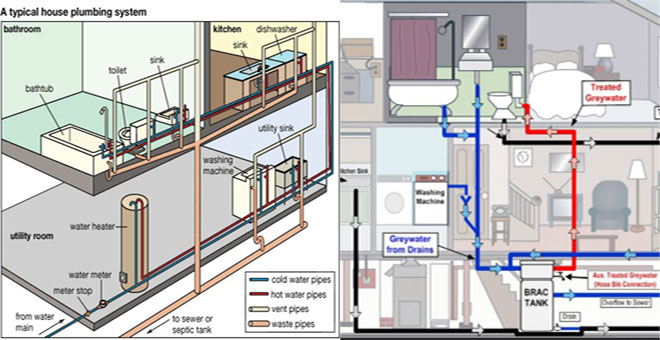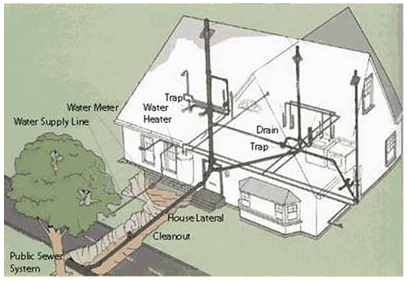Breaking Down Your House's Plumbing System Anatomy
Breaking Down Your House's Plumbing System Anatomy
Blog Article
Are you currently in search of advise involving Anatomy of a House: Understanding the Components?

Understanding exactly how your home's pipes system works is necessary for every homeowner. From providing tidy water for drinking, cooking, and showering to securely removing wastewater, a properly maintained plumbing system is vital for your family members's health and comfort. In this thorough guide, we'll discover the intricate network that composes your home's pipes and deal tips on maintenance, upgrades, and taking care of usual problems.
Introduction
Your home's plumbing system is more than just a network of pipelines; it's an intricate system that guarantees you have accessibility to clean water and effective wastewater elimination. Understanding its parts and exactly how they interact can aid you prevent costly repairs and guarantee everything runs efficiently.
Fundamental Parts of a Plumbing System
Pipes and Tubing
At the heart of your plumbing system are the pipelines and tubing that bring water throughout your home. These can be made from various materials such as copper, PVC, or PEX, each with its advantages in regards to durability and cost-effectiveness.
Fixtures: Sinks, Toilets, Showers, and so on.
Fixtures like sinks, toilets, showers, and bathtubs are where water is used in your house. Recognizing just how these components attach to the pipes system assists in identifying issues and planning upgrades.
Shutoffs and Shut-off Factors
Valves control the circulation of water in your pipes system. Shut-off valves are essential during emergency situations or when you require to make repair services, enabling you to isolate parts of the system without interfering with water circulation to the entire house.
Water Supply System
Key Water Line
The major water line links your home to the local water system or a personal well. It's where water enters your home and is distributed to various components.
Water Meter and Stress Regulator
The water meter steps your water usage, while a stress regulatory authority makes sure that water streams at a secure stress throughout your home's pipes system, protecting against damages to pipes and fixtures.
Cold Water vs. Hot Water Lines
Recognizing the difference in between cold water lines, which supply water straight from the major, and hot water lines, which carry warmed water from the hot water heater, assists in troubleshooting and preparing for upgrades.
Drain System
Drain Piping and Traps
Drain pipelines bring wastewater away from sinks, showers, and commodes to the drain or septic tank. Catches avoid sewage system gases from entering your home and likewise trap debris that might cause obstructions.
Ventilation Pipelines
Ventilation pipelines permit air into the water drainage system, avoiding suction that can slow down drainage and trigger traps to vacant. Proper air flow is vital for keeping the stability of your pipes system.
Significance of Proper Water Drainage
Guaranteeing correct drainage stops backups and water damage. Routinely cleansing drains and maintaining traps can avoid costly fixings and expand the life of your pipes system.
Water Furnace
Types of Water Heaters
Hot water heater can be tankless or traditional tank-style. Tankless heaters warmth water on demand, while containers save warmed water for instant use.
Upgrading Your Plumbing System
Reasons for Updating
Updating to water-efficient components or replacing old pipes can enhance water top quality, reduce water expenses, and boost the worth of your home.
Modern Pipes Technologies and Their Advantages
Discover modern technologies like clever leakage detectors, water-saving toilets, and energy-efficient water heaters that can save money and minimize ecological influence.
Cost Considerations and ROI
Compute the upfront prices versus long-lasting savings when taking into consideration plumbing upgrades. Several upgrades pay for themselves with minimized utility bills and fewer repair work.
Exactly How Water Heaters Link to the Pipes System
Recognizing just how water heaters connect to both the cold water supply and hot water distribution lines assists in identifying issues like inadequate hot water or leakages.
Upkeep Tips for Water Heaters
Routinely flushing your water heater to remove sediment, checking the temperature settings, and inspecting for leaks can expand its life expectancy and boost power effectiveness.
Usual Pipes Problems
Leakages and Their Causes
Leaks can take place as a result of aging pipes, loosened installations, or high water stress. Attending to leaks without delay stops water damages and mold growth.
Obstructions and Obstructions
Blockages in drains and bathrooms are typically caused by flushing non-flushable things or a build-up of grease and hair. Using drain displays and being mindful of what goes down your drains pipes can prevent obstructions.
Indications of Plumbing Troubles to Look For
Low water pressure, slow drains, foul odors, or uncommonly high water bills are indicators of prospective plumbing issues that need to be addressed without delay.
Plumbing Upkeep Tips
Routine Inspections and Checks
Set up annual plumbing examinations to catch concerns early. Try to find signs of leakages, rust, or mineral build-up in taps and showerheads.
DIY Upkeep Tasks
Basic tasks like cleansing faucet aerators, looking for toilet leakages utilizing color tablet computers, or protecting exposed pipelines in cold environments can avoid significant pipes problems.
When to Call a Specialist Plumbing Technician
Know when a plumbing concern requires expert expertise. Attempting intricate repair services without proper understanding can lead to even more damage and higher repair service costs.
Tips for Lowering Water Usage
Straightforward practices like repairing leakages without delay, taking shorter showers, and running complete loads of washing and recipes can conserve water and reduced your energy expenses.
Eco-Friendly Pipes Options
Think about sustainable plumbing products like bamboo for flooring, which is durable and green, or recycled glass for kitchen counters.
Emergency Readiness
Actions to Take During a Plumbing Emergency situation
Know where your shut-off shutoffs are located and exactly how to turn off the supply of water in case of a ruptured pipeline or significant leakage.
Importance of Having Emergency Get In Touches With Useful
Keep get in touch with information for neighborhood plumbing professionals or emergency services readily offered for quick reaction during a plumbing crisis.
Environmental Influence and Preservation
Water-Saving Components and Devices
Mounting low-flow faucets, showerheads, and commodes can considerably reduce water use without compromising performance.
DIY Emergency Fixes (When Appropriate).
Momentary repairs like making use of air duct tape to spot a dripping pipeline or putting a container under a leaking faucet can lessen damage up until a professional plumbing arrives.
Conclusion.
Understanding the anatomy of your home's plumbing system empowers you to keep it properly, conserving time and money on repair work. By following regular upkeep routines and remaining notified regarding modern-day plumbing innovations, you can guarantee your plumbing system runs efficiently for several years to find.
HOW YOUR PLUMBING SYSTEM WORKS
Which Pipes Do What?
Blue lines = fresh water supply entering the building Red lines = hot water supply entering the building Grey lines = pipes carrying waste away from the building and venting pipes carrying gases away from the building (through the roof) YOUR MAIN PLUMBING SYSTEMS
There are two main plumbing systems that support your home s basic plumbing needs one that brings clean water into your home, and one that sends dirty water away from your home. Connected to the toilet, bath, shower, and other faucets in your home, these two systems keep your water flowing in the right directions.
ACCESSING FRESH WATER
Fresh and clean water is brought into your home through the main water supply line . Filtered through one pipe, this water is pressured to flow into the various fixtures in your home at any given time.
This water can be sourced from a well located on your property, a pond or river (mostly cottages), or, as in most cases, from the city s municipal water treatment centre. However, it is important to note that water that is untreated, such as the water siphoned from ponds or rivers, may not be safe to drink. Personal water supplies always need to be treated for hardness and contaminants before consumed.
MUNICIPAL WATER SUPPLIES
Improve taste and odour Remove sediment Eliminate hardness Reduce chlorine COLD WATER SUPPLY VS. HOT WATER SUPPLY
Cold water flows into your home or building through the service line, which then distributes hot or cold water to your fixtures. This line is most commonly run through a central column that runs floor to floor. Hot water runs in short and straight pipes as the longer the pipeline, the more heat that will be lost in the transfer. Having shorter pipes also allows residents to access hot water more quickly.
WASTE WATER SYSTEM
Your wastewater system is divided into two parts pipes that send wastewater away from your home and venting pipes that send sewer gas away from your home. Sewage water travels through pipes that flush the water and waste towards local sewers that are operated and managed by your city or town. Most sewer systems rely on gravity to move the wastewater to where it needs to go.
The further away from your toilet or sink, the larger wastewater pipes become. This allows for waste to be disposed of from various parts of your home or business at once without pipe blockages. The angle and flow of these pipes are also essential for keeping your waste pipes clear of build up.
https://harrisplumbing.ca/how-your-home-plumbing-system-works/

I was made aware of that write-up on Understanding Your Home's Plumbing Anatomy through a friend on a different site. Do you know about somebody else who is sincerely interested in the niche? Why not share it. Thanks for your time spent reading it.
Call Today Report this page